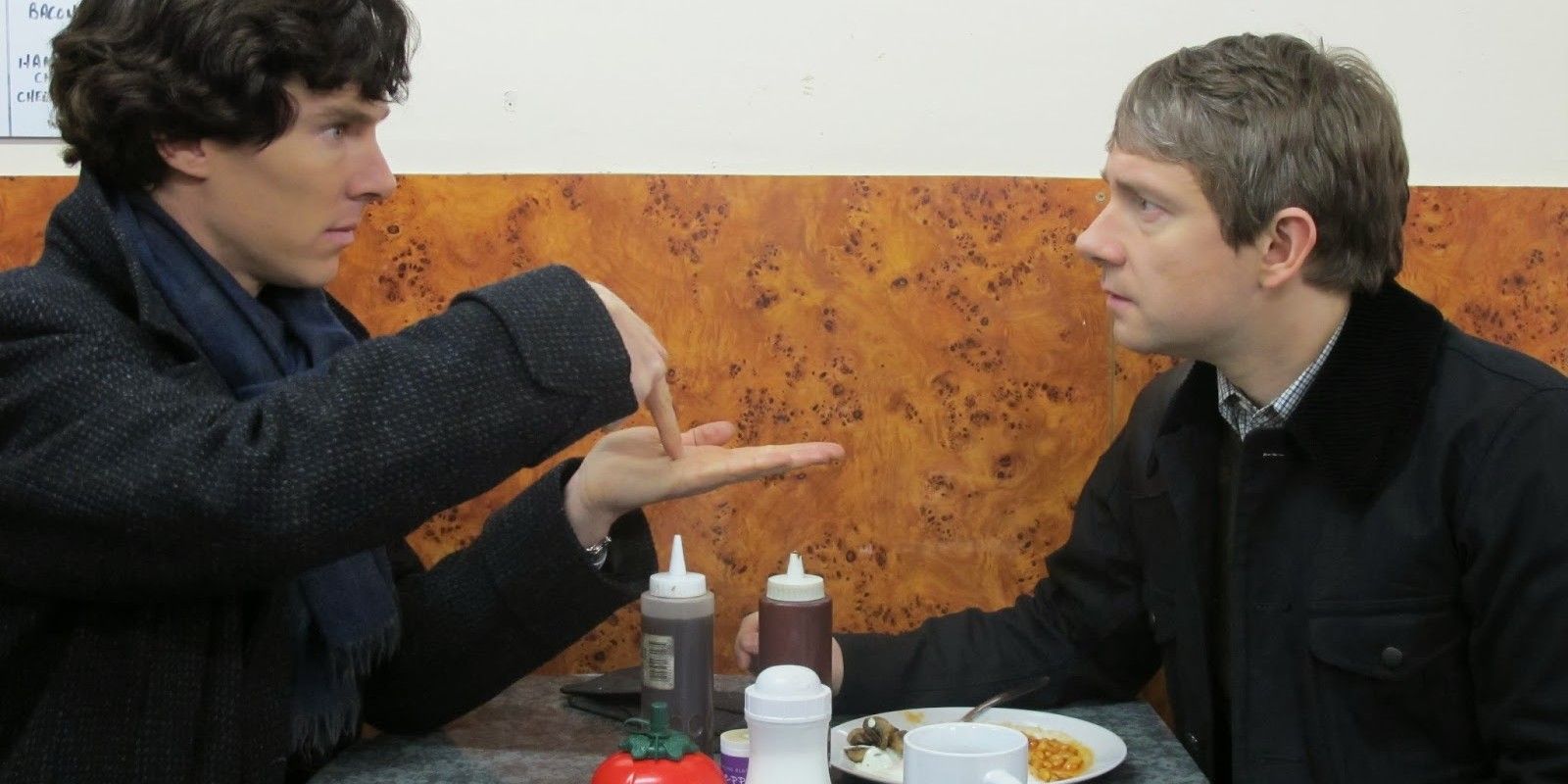Sherlock Holmes is one of the most popular and beloved characters in literature, and for years, fans have made him their own, giving him new stories or even adding to his mysterious backstory, and in some cases, they have gone as far as to write theories about Sherlock and company. One of the most recent adaptations of the character, the BBC’s Sherlock, made way for a new interpretation of Sir Arthur Conan Doyle’s characters and a conspiracy theory based on the Johnlock pair – and here’s what it is all about.
Sherlock Holmes made his debut in 1887 in A Study in Scarlet and went on to appear in a total of four novels and 56 short stories. The Great Detective has been adapted to all types of media for over a hundred years, and one of its most recent TV adaptations was Sherlock, created by Mark Gatiss and Steven Moffat. The series brought Sherlock (played by Benedict Cumberbatch) and John Watson (Martin Freeman) to the modern world, with up-to-date reinterpretations of their cases as well as new stories. Sherlock was praised by critics and viewers for its writing, acting, and direction, though the final season wasn’t a favorite and saw a decline in quality.
The series became very popular, expanding the Sherlock Holmes fandom and creating its own “sub-fandom”. Sherlock fans took over the internet to share their fanart, fanfiction, and their theories about the show, especially after Sherlock’s supposed death in “The Reichenbach Fall” in season 2. When the series brought Sherlock back in season 3, the writers included multiple explanations on how he survived without really revealing how he did it, and it was obvious they took a look at the most popular fan theories to come up with some possible ways in which he faked his death. However, one fandom-created thing Sherlock completely ignored was “Johnlock”, which in turn made way for a full conspiracy theory that not many fans of the famous detective might be aware of. Here’s what you need to know about the "Johnlock Conspiracy" theory that originated from the series Sherlock.
Sherlock: The Johnlock Ship Explained
In fandom (of any movie, TV show, video game, and more), the term “ship” or “shipping” comes from the word “relationship”, and it’s the desire by fans for two characters (either real or fictional) to be in a romantic relationship. “Ships” are the subject of many pieces of fanart and the core of many fanfics, and they don’t have to be canon for fans to have fun with them. Sherlock had its own ship thanks to the bond between Sherlock and John, which fans affectionately and appropriately named “Johnlock”. The ship and every piece of fanart and fanfiction reached their peak during the series’ run, though there are still fans who share their support for Johnlock through new works.
Sherlock showrunners were well-aware of the existence of Johnlock and the fan pressure that came with it, with Moffat assuring fans multiple times that, while they lied about various plot holes and purposedly misled them many times, Johnlock was never part of their plans. In an interview with The Guardian in 2012, Moffat shared he wanted to keep Sherlock’s celibacy as it is in the source material, explaining that there’s no indication in Conan Doyle’s stories that he was “asexual or gay”, and even said he “declines the attention of women because he doesn’t want the distraction”. Moffat went on to explain that Sherlock wouldn’t live with a man if he “thought men were interesting”, and it was “the choice of a monk, not the choice of an asexual”. However, this wasn’t enough to stop fans from imagining what could happen if Sherlock and John had feelings for each other and even found “evidence” that Johnlock was real, even if Moffat said the contrary.
The Evidence for Johnlock in Sherlock
From the very beginning of Sherlock, a possible attraction between Sherlock and John was hinted at and almost immediately shut down by them (mostly John). In the first episode, Sherlock and John were having dinner and the latter thought the detective was into men, and in turn, Sherlock thought John was coming on to him, so he replied that he was “married to his work”. Once they began living and working together, various characters close to them simply assumed they were a couple, among those Mrs. Hudson. Later on in the season, Sherlock didn’t seem to be ok with John going on a date and invited himself to it, and Moriarty once said that John was Sherlock’s “heart”. In Sherlock season 2, Irene Adler insisted they were a couple, much to John’s frustration, and in “The Hounds of Baskerville”, the innkeeper mistook them for a couple.
Sherlock season 3 introduced Mary Morstan (Amanda Abbington), who went on to become John’s wife, which reportedly prompted fans to send death threats to Abbington in hopes that with enough fan pressure, Moffat and company would make Johnlock canon. Sadly for Johnlock supporters, Sherlock never made the ship canon, and the teased attraction between them ended up being used “for the laughs”, which in turn prompted fans to accuse Moffat and Gatiss of “queerbaiting” – and this made way for the “Johnlock Conspiracy Theory”.
Sherlock: The Johnlock Conspiracy Theory Explained
The Johnlock Conspiracy (TJLC) is a fan theory created by Sherlock fans and which can be found primarily on Tumblr. The theory originated after the episode “The Sign of the Three” aired in January 2014, and the core of it is that the producers and writers of Sherlock had always intended to make Johnlock canon, and had to lie in press conferences and more to keep it a secret and thus surprise viewers with “the big reveal”. The “conspiracy” part of it is because of the lies Moffat and company shared throughout Sherlock’s run, emphasizing that “people can’t be trusted”.
The TJLC doesn’t agree with Johnlock evidence being “queerbaiting”, instead considering all those teases as actual hints of what was going to happen at some point in the series. Many Johnlock shippers and TJLCers appreciated the ambiguity that many called queerbaiting, even saying that Sherlock challenged traditional expectations of romance and relationships. To prove their point, TJLCers have over-analyzed the show through their own lens and dissected it in order to find evidence in every single detail – from the soundtrack to shot composition and even colors and lighting. In fact, some supporters of the theory have even shared the main points of the theory and the specific lens they watch the series through, with these being ignoring John’s protestations of not being gay, Sherlock being gay, phones being metaphors of John or Sherlock’s heart, waiters being metaphors for emotions, Mycroft being the representation of Sherlock’s suppression of his emotions, and many (truly many) objects representing sex, sexual desire, love, and homosexuality.
Fans and supporters of the theory spent a lot of time analyzing the series and sharing their interpretations online, and though season 4 didn’t include the “big reveal” they had been waiting for, that didn’t stop TJLCers. Some of them maintain that the series finale, “The Final Problem”, was an “intentionally bad nightmare episode” and there’s a fourth, still un-aired, episode (“The Lost Special”) that will finally make Johnlock canon, while some others claimed to be “traumatized” by Johnlock not being included and went back to the initial allegations of queerbaiting.
The Problems With Sherlock’s Johnlock Theory & Conspiracy
Ships are very common in all fandoms, and there’s nothing wrong with them, but the problems of Johnlock are related to the Conspiracy. There have been allegations of harassment both towards TJLCers and from them to other Sherlock fans, turning the Sherlock fandom into a toxic environment. Many supporters of the theory (and some of its most prolific writers) ended up leaving Tumblr and other social media due to intense trolling and bullying both on and off-line. Fandoms should be a safe environment for fans to share their views, opinions, interpretations, and works related to the TV show, movie, or whatever piece of media they support, and they become problematic once it turns toxic, either towards the fans or the creators (as has been the case with the Star Wars fandom).
Another problem related to Johnlock and TJLC is the “queerbaiting” debate. This marketing technique is used to attract a specific audience without really delivering on what’s being teased. Sherlock has been used as an example of queerbaiting thanks to all the aforementioned evidence of Johnlock, later contradicted by Moffat, Gatiss, and the cast, mostly Martin Freeman. As mentioned above, the romantic subtext between Sherlock and John ended up being used “for the laughs”, which was insulting to viewers and the LGBTQ+ community, who keep fighting for proper (and better) representation in the media.
Although Sherlock is now over and there are no plans for a fifth season, with season 4’s finale wrapping up the arcs of Sherlock and John, Johnlock shippers continue to share their work on different social media platforms, and “The Johnlock Conspiracy” theory is still alive, but it might not have the same amount of support it initially had.





